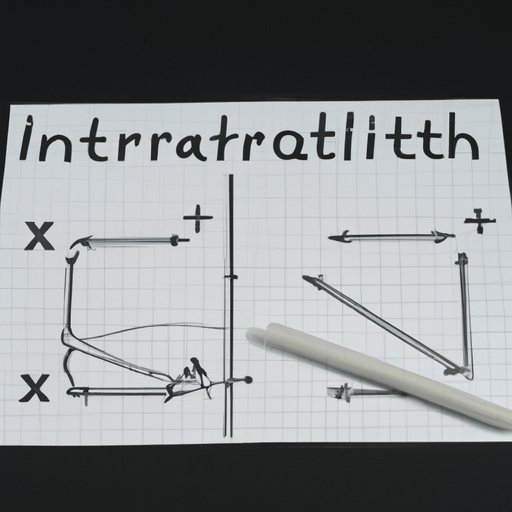I. Introduction
Welcome to this step-by-step guide on how to find the x-intercept. Mathematics is a subject that often requires a keen eye for detail, and f inding the x-intercept is one of the basic and essential concepts in algebra. This article is aimed at students or anyone who wants to embrace math inside and outside the classroom. With this guide, you’ll learn to find the x-intercept with ease!
II. Step-by-Step Guide
Before learning how to find the x-intercept, let’s first define what it means. The x-intercept is the point at which a line, curve, or function intersects the x-axis. This point represents the value of x when y is equal to zero, and it’s an essential concept in algebra and graphing.
So, how do you find the x-intercepts? It’s a simple process if you follow these steps:
A. Graphing
If you have an equation that contains x, it’s best to graph it first. The graph gives you a visual representation of the function, making it easier to determine where it intersects with the x-axis.
For example, let’s take the equation y = 2x + 4. To graph this equation, we only need to plot two points on the plane:
- When x = 0, y = 4
- When x = 1, y = 6
Using these two points, we can plot the graph of the equation using a straight line.
Now, to find the x-intercept, we look for the point where y = 0. On this graph, we can see that it intersects the x-axis at the point -2. This value represents the x-intercept of this equation.
B. Solving for x
Another way to find the x-intercept is by solving the equation for x. To do this, we set y equal to zero and solve for x.
Let’s take another example where y = x^2 – 4x + 3. To find the x-intercepts, we set y equal to zero:
0 = x^2 – 4x + 3
This equation can be factored by finding two numbers that multiply to 3 and add up to -4:
(x – 3)(x – 1) = 0
From this equation, we get two possible values of x that solve for the x-intercepts: x=1 and x=3.
III. Visual Demonstration
We know that visual aids are helpful to learn any subject better, and mathematics is no exception. We can use diagrams, pictures, or video tutorials to help us understand the concept of finding the x-intercept.
Here’s a video tutorial that shows how to find the x-intercept of a quadratic function:
IV. Real-World Applications
When learning mathematical concepts, it’s essential to know how they can be applied in the real world. The x-intercept has many practical applications, including:
A. Calculating x-intercepts on a velocity vs time graph
In physics, the x-intercept of a velocity vs time graph represents the time at which an object comes to a stop.
For example, suppose a car is moving at a constant velocity of 40 mph. If it suddenly applies the brakes, the velocity vs time graph will look like a straight line that passes through the x-axis. The x-intercept will represent the moment that the car comes to a stop.
B. Finding roots of quadratic equations
The x-intercepts of a quadratic equation can give us the roots of the equation. These roots help us to solve practical problems, including those related to engineering, physics, and computer science.
Let’s take an example applied in physics. Suppose you are given the height of an object that is thrown into the air. You also know the velocity at which it was thrown. To find the total time it takes for the object to hit the ground, you must find the roots of the equation that defines its motion. The x-intercepts in this case would give you the time at which the object was at the ground level.
V. Comparison to y-intercepts
Understanding the concept of the x-intercept is essential in graphing, but it’s also important to understand the difference between x-intercepts and y-intercepts.
A. Definition and explanation of y-intercepts
The y-intercept is the point at which a line, curve, or function crosses the y-axis. Unlike the x-intercept, which represents the value of x when y is equal to zero, the y-intercept represents the value of y when x is equal to zero.
B. Comparison and contrast of x-intercepts with y-intercepts
Both x-intercepts and y-intercepts are essential concepts when graphing and understanding algebraic equations. They have fundamental differences in how they help us understand the function, but both represent where the function intersects an axis on the graph plane.
C. Illustrative examples for the comparison
Let’s take an example showing the difference between x-intercepts and y-intercepts:
Suppose you have the equation y = -2x + 6. When we graph this equation, we can see that it intersects the y-axis at the point 6. This point represents the y-intercept. To find the x-intercept, we must set y equal to 0 and solve for x, which gives us the point (3,0).
VI. Common Mistakes to Avoid
Finding the x-intercept may seem easy, but some common mistakes can lead to incorrect solutions. Here are a few errors to avoid:
- Forgetting to set y equal to zero when solving for x
- Graphing error, especially when dealing with complex equations
- Not reading the signs carefully when finding x-intercepts of a quadratic equation
Always double-check your work and read the problem carefully to avoid these mistakes.
Conclusion
Congratulations, you have learned how to calculate the x-intercept with a step-by-step guide, visual aids, and much more. Remember that practice is the key to mastering mathematical concepts. Now, go ahead and practice!
If this guide helped you or you want to make any comments/ feedback, please leave them in the comment section.
